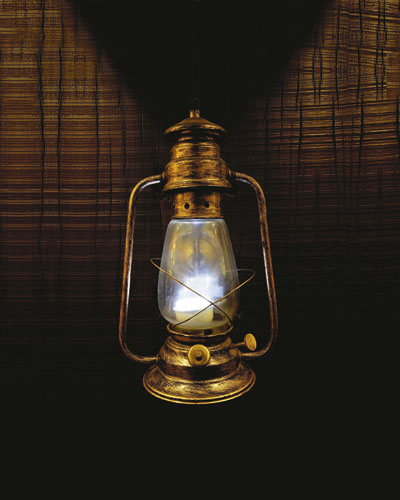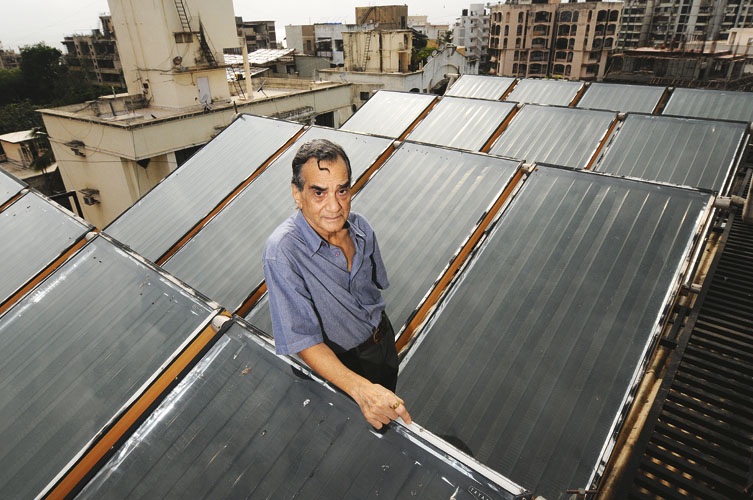
Home Green Home
Green living isn't an expensive indulgence any more; it makes cold, hard economic sense
Navin Chandra is enthusiastic as he takes me to the roof of Sea Line, a seven-storeyed building in Bandra, Mumbai. This slightly built man walks and talks with an energy that belies his 79 summers. He is explaining the social and economic benefits of living green.
“Sixty lights in the common area as well the computer in my office are powered by this panel,” he says. This saves them 300 units of grid electricity a month. At today’s rates, that's Rs. 2,100 every month.
Environmentalists, like most do-gooders, expect you to accept their ideas purely because they’re worthy. Smart advertisers know that the only argument that sells is the one that answers this question: What’s in it for me? With green living, the answer to that is, increasingly, “money!” As with almost any aspect of life, science has helped make affordable things that were once expensive indulgences. Even better, these little changes to the way we live can actually save us money. I.e., you don’t have to do it for the polar bears; you’re just looking out for yourself.
The total cost of the solar heater and panels was around Rs. 9 lakh. With the cost of electricity rising every year, Chandra expects the system to pay for itself in five years. After that it’s all profit.
Experts say it should be even less. Vikram Shetty, GM of Twincity Sunlife, a solar energy products and services company says, “The most it should take is three years. The average life of a heater is 22 years.” The panels face south and all you need is five-six hours of good sunlight to heat water. The water stored in the insulated tanks remains hot for up to 72 hours; so you need just one day of good sunlight every three days.
India faces a severe energy crisis. Power companies are increasing tariffs and supply is dwindling. Electricity prices are rising by at least 2.5 percent every year. Mumbai has largely been cut off from the power famine in India because of its status as the financial hub of the country and also because its citizens pay a higher tariff for both electricity and water. Higher bills aside, they are starting to face the heat, literally. Some suburbs already face power cuts. Water on alternate days, power cuts every day, calling tankers in, all of these may soon become a regular occurrence. They must adopt green solutions. What is in their favour is that green energy products have gotten a lot cheaper, and they can look for guidance to other cities that have adopted green energy to combat crises.
The Thane Municipal Corporation in Maharashtra has made it compulsory for buildings like hospitals, guest houses, hostels and the like to have solar heating. Delhi, reeling under power cuts for some years now, offers a rebate of Rs. 6,000 for every home that installs a solar water heater. Uttaranchal provides Rs. 50 per month as rebate in the electricity tariff to users of solar water heaters.
If your neighbours are not keen on a common heater, you can opt for one just for your house. Twincity reckons a 115 litre water tank should do fine for a family of four. At Rs. 18,500, they say monthly savings could touch Rs. 695 a month.
“It’s time people understand this is an investment, not a cost,” says Chandra. Sea Line also harvests rainwater. This means they charge the water received during the monsoons back to the earth and withdraw it for their daily needs from three bore wells. “I think we charge more water into the ground than what we use for our daily needs,” Chandra says. And they use the water for everything from watering plants to baths to cleaning cars.
Sea Line hasn’t suffered from water cuts so far, thanks to its prime location and the fact that minister for industries, Narayan Rane, is a resident.
Not all buildings are as fortunate. Hyde Park Galaxy, a building complex in Thane district, used to suffer from a lot of water cuts. They used to spend Rs. 10,000 on water tankers every year. Ever since they began water harvesting in 2007, they haven’t had to call the tanker guys. “We spent Rs. 40,000 on the whole system. Both our buildings, with a total of 56 flats, don’t have to rely on Municipal water,” says Rajesh Parakh, chairperson of the housing society. While the rest of us have to contend with water cuts due to a bad monsoon, these buildings are set for the year.
It’s not surprising, says Chandra Bhushan, associate director, Centre for Science and Environment, Delhi. “By definition itself, green living is cheaper. Green energy products require an initial investment, but you can amortise the cost over five-seven years.” He advocates going completely green. “You have to make changes in your lifestyle. You have to be careful on how you use resources. You also have to change your diet. A daily non-veg diet consumes 5,000 litres of water, while a vegetarian diet consumes only 1,000 litres. And you have to stop wasting fuel.”
He knows what he’s saying is not completely feasible.
It is not easy convincing people to change diets. And greener commuting? Our substandard, to put it politely, public transport facilities mean that most people switch to a private vehicle as soon as they can afford to. Such electric vehicles as are available are rather shoddy. Hybrid cars are still too expensive.
“But, you can still do a lot. Switch over to LED lights. Yes, it’s expensive, but look at the savings it generates. A 10 watt LED generates the same light that a 100 watt incandescent bulb or a 40 watt CFL light does,” Bhushan says. Companies like Samsung, Philips and Siemens, who produce LEDs, claim savings of up to 85 percent through LED usage.
If you run one air-conditioner for eight hours every night, it consumes around 3000 units of electricity a year. Solar power right now takes too much space for it to be a feasible option to run power-sucking products like microwaves and refrigerators. But you can run the lights and fans in your house by opting for a 0.5 KW powered solar power system and stay off the grid for that much less. It costs Rs. 1.5 lakh, and pays for itself within five years. But people are unconvinced.
“People are ready to pay Rs. 5 crore to own a flat in expensive buildings. But ask them to pay Rs. 50,000 to go green and they’ll say it’s too expensive without realising that they are losing out on massive savings,” notes Chandra with a wry smile. The green warriors know they have a long road ahead.
That it's a road we must all travel, though, is no longer in doubt.
Buy energy rated products that meet the Bureau of Energy Efficiency standards. The higher the number of stars on the product, the better it is.
Use dual flush toilets. You’ll save up to 65 percent of water every flush.
Convert to LED lights. They cost 10 times as much as CFL bulbs, but they last for 25 years and save 90 percent electricity.
A non-veg diet in the West consumes 5,000 litres of water a day. An Indian vegetarian diet consumes 1,000 litres of water.
Switch off your electric appliances when not needed. A TV on standby still consumes 80 percent of electricity.
Living Off the Grid
A.R. Shivakumar, executive secretary, Karnataka State Council for Science and Technology, lives in a house that almost manages to stay off the grid. When he began to build his house, 14 years ago, he used harvested rainwater.
“We don’t have a city connection. The groundwater below my house provides me with 250,000 litres of the purest water available. A family of four doesn’t use more than 150,000 litres a year.”
He should know. He has been working on energy-related issues for 28 years.
His home looks like a cool, leafy resort. But it’s in one of India’s most crowded metros: Bangalore. Skylights in the roof mean there’s no need for lights during the day. There's a solar water heater, and photovoltaic panels, which he installed when he built the house.
“I have spent Rs. 25,000 on the three 35 watt panels and have changed the battery twice. That cost me Rs. 4,500 each time. The water heater cost me Rs. 7,000. I recovered the whole cost within five years,” he boasts.
Government Help
- Delhi provides a rebate of Rs. 6,000 for every solar water heater.
- Rebate in electricity tariff in the monthly bills is also being given in five states to users of solar water heaters.
- Soft loans will be provided at 2 percent to domestic users. North-East states, Sikkim, Himachal Pradesh, J&K and Uttaranchal, Chattisgarh and Jharkhand, domestic users get interest-free loans.
- Builders of housing complexes get a rebate of Rs. 1900 /- per square. metre for installing solar water heaters.
(This story appears in the 28 August, 2009 issue of Forbes India. To visit our Archives, click here.)
-
 Suchita
SuchitaI read this article, it's very nice. I want to built a green house in 1500 sq.ft. I want to know how much it's cost. waht it is the meaning of green house etc. Please give me reply, it's urgent.
on Jul 14, 2011 -
 Avneesh
AvneeshWe need to popularise such green ideas... I did my bit by posting some of the Quick Green Fixes on facebook.
on Aug 17, 2009 -
 rakesh
rakeshcan you suggest some companies that provide services for green homes in India
on Feb 27, 2010-
 Azim Penangwala
Azim PenangwalaDear Mr. Rakesh Hi, this is Azim here from aluZza Eco Tech we are based in Mumbai and Pune, India We provide green living solutions. We are professionally into consultation and implementation of rain water harvesting, grey water recycling and water consevration activities.. if any query you can feel free to contact us at helpconservewater@gmail.com or feel free to call me on 09320082183.
on Dec 27, 2010
-
















